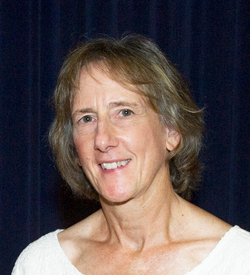Biography:Alice Harding
Alice K. Harding | |
|---|---|
 Harding in 2012 | |
| Alma mater | Bryn Mawr College (BA), University of Massachusetts-Amherst (PhD) |
| Awards | Bruno Rossi Prize 2013 |
| Scientific career | |
| Fields | Astrophysics |
| Institutions | NASA Goddard Space Flight Center |
| Thesis | Propagation in Pulsar Magnetospheres: Effects of A Shearing Plasma (1979) |
Alice Kust Harding is an American astrophysicist at the NASA Goddard Space Flight Center, Greenbelt, Maryland.
Early life and education
Harding earned a B.A. from Bryn Mawr College, Pennsylvania, in 1973,[1] and a Ph.D. from the University of Massachusetts-Amherst, in 1979.[2]
Career and research
In 1980, Harding was appointed as astrophysicist in the Astrophysics Science Division at Goddard Space Flight Center, a post she has held since then. Her main research interests have been high-energy particle acceleration and radiation processes in pulsars, highly magnetized neutron stars (magnetars), gamma-ray bursts, and supernova remnants.[3]
Harding works as part of astrophysics collaborations including the NICER Science Team, the Fermi Collaboration[3] and AMEGO.[4]
Awards and honours
Harding was awarded the status of Fellow[5] in the American Physical Society,[6] after being nominated by their Division of Astrophysics in 1991,[7] for pioneering investigation of the theory of pulsar atmospheres, including the pulsar wind and its role in accelerating particles to high energies, and for contributions to the theory of basic electromagnetic interactions in the presence of super-strong magnetic fields.
In 1994, Harding received a NASA Exceptional Scientific Achievement Medal in 1994.[1] In 2012, she was awarded the John C. Lindsay Memorial Award in recognition of her scientific achievements at Goddard.[8]
Harding was awarded the 2013 Bruno Rossi Prize together with Roger W. Romani for establishing a theoretical framework for understanding gamma-ray pulsars.[9][10] She was elected a Legacy Fellow of the American Astronomical Society in 2020.[11]
References
- ↑ Jump up to: 1.0 1.1 "NASA Astrophysicist Alice K. Harding '73 to Open Summer Series of Lectures by Prominent Women in Science". June 23, 2011. https://news.blogs.brynmawr.edu/2011/06/23/nasa-astrophysicist-alice-k-harding-73-to-open-summer-series-of-lectures-by-prominent-women-in-science/.
- ↑ "Astronomy Alumni & PhD Theses". https://www.astro.umass.edu/academics/grad/thesis.
- ↑ Jump up to: 3.0 3.1 "Alice K. Harding". APS. https://physics.aps.org/authors/alice_k_harding. Retrieved 28 September 2020.
- ↑ "AMEGO: Team". https://asd.gsfc.nasa.gov/amego/team.html.
- ↑ "APS Fellowship" (in en). https://www.aps.org/programs/honors/fellowships/.
- ↑ "APS Fellow Archive" (in en). https://www.aps.org/programs/honors/fellowships/archive-all.cfm?initial=&year=&unit_id=&institution=.
- ↑ "APS Fellows 1991" (in en). https://www.aps.org/programs/honors/fellowships/archive-all.cfm?initial=&year=1991&unit_id=&institution=.
- ↑ "Lindsay Awards and Lectures". https://scicolloq.gsfc.nasa.gov/Lindsay_Awards.html.
- ↑ "HEAD AAS Rossi Prize Winners | High Energy Astrophysics Division". https://head.aas.org/rossi/rossi.recip.html#AC.
- ↑ Administrator, NASA (2013-06-06). "NASA Goddard Astrophysicist Wins Prize for Pulsar Work" (in en). http://www.nasa.gov/centers/goddard/news/features/2013/harding-rossi-prize.html.
- ↑ "AAS Fellows". AAS. https://aas.org/grants-and-prizes/aas-fellows. Retrieved 28 September 2020.
 |


